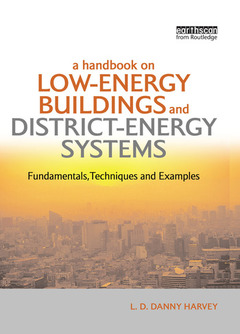A Handbook on Low-Energy Buildings and District-Energy Systems Fundamentals, Techniques and Examples
Auteur : Harvey L.D. Danny

Winner of Choice Magazine - Outstanding Academic Titles for 2007
Buildings account for over one third of global energy use and associated greenhouse gas emissions worldwide. Reducing energy use by buildings is therefore an essential part of any strategy to reduce greenhouse gas emissions, and thereby lessen the likelihood of potentially catastrophic climate change. Bringing together a wealth of hard-to-obtain information on energy use and energy efficiency in buildings at a level which can be easily digested and applied, Danny Harvey offers a comprehensive, objective and critical sourcebook on low-energy buildings. Topics covered include: thermal envelopes, heating, cooling, heat pumps, HVAC systems, hot water, lighting, solar energy, appliances and office equipment, embodied energy, buildings as systems and community-integrated energy systems (cogeneration, district heating, and district cooling). The book includes exemplary buildings and techniques from North America, Europe and Asia, and combines a broad, holistic perspective with technical detail in an accessible and insightful manner.
Date de parution : 11-2015
17.8x25.4 cm
Date de parution : 08-2006
Ouvrage de 448 p.
20.1x25.8 cm
Thèmes d’A Handbook on Low-Energy Buildings and District-Energy... :
Mots-clés :
Energy Savings; heat; Heat Pumps; pump; Liquid Desiccant; cooling; Absorption Chillers; loads; VCCs; absorption; Commercial Buildings; chiller; Exhaust Air Heat Pumps; tower; Cooling Tower; liquid; Cooling Load; desiccant; Thermal Energy Storage; exhaust; Heat Exchanger; Electric Chiller; DHW; Desiccant Wheel; Adsorption Chillers; Chilled Water; Embodied Energy; Hybrid Ventilation; EC; Trombe Walls; Evaporator Temperature; Desiccant System; Energy Payback Time; Solar Thermal Energy; Window U-value



